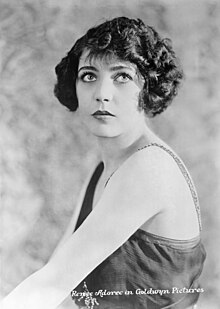Renée Adorée
| Renée Adorée | |
|---|---|
 |
|
| Born |
Jeanne de la Fonte 30 September 1898 Lille, Nord, France |
| Died | 5 October 1933 (aged 35) Tujunga, California, U.S. |
| Cause of death | Tuberculosis |
| Occupation | Actress |
| Years active | 1918–1930 |
| Spouse(s) |
Tom Moore (m. 1921; div. 1924) William Sherman Gill (m. 1927; div. 1929) |
Renée Adorée (30 September 1898 – 5 October 1933) was a French actress who appeared in Hollywood silent movies during the 1920s.
Born Jeanne de la Fonte in Lille, she was the daughter of circus artists and by age five was performing with her parents. In her teens, she began acting in minor stage productions and toured Europe with her troupe. She was performing in Russia when World War I broke out and fled to London.
Having made a reputation in England and Australia for her dancing skills, she went to New York City very early in 1919, where she was cast in a snappy vaudeville-style Shubert musical revue called Oh, Uncle which opened at the Garrick Theatre in Washington, D.C., in March 1919; by mid March it was being staged in Trenton, New Jersey, and subsequently toured through the summer. In July, it was renamed Oh, What a Girl! and opened at the Shubert Theatre in New York City. Over the next several months, she toured in another Shubert production, The Dancer. By January 1920, the opportunity arose for her to work in the motion picture business when she was cast in The Strongest, a dramatic photoplay written by France's celebrated Prime Minister, Georges Clemenceau.
Before coming to America, she already had adopted the romantic stage name "Renée Adorée" (French for "reborn" and "adored," both in the feminine form), and was billed as such in an Australian film produced in 1918. While in New York City on New Year's Eve 1921 she met Tom Moore (1883–1955), who was 15 years her senior. Moore and his brothers were Irish immigrants who had become popular Hollywood actors. Six weeks after their meeting, on 12 February 1921, Adorée married Moore at his home in Beverly Hills, California. The marriage ended in divorce in 1926 and, in June 1927, Adorée married again, this time to William Sherman Gill.
She is most famous for her role as Melisande in the melodramatic romance and war epic The Big Parade (1925) opposite John Gilbert. It became one of MGM's all-time biggest hits and a film that historians rank as one of the best of the silent film era. In The Mating Call a 1928 film produced by Howard Hughes, Adorée had a very brief nude swimming scene that caused a significant commotion at the time.
...
Wikipedia
